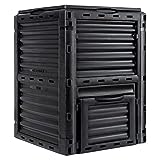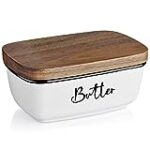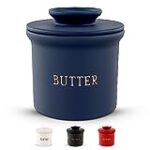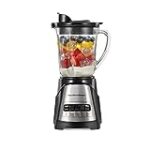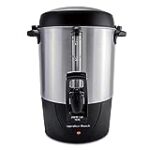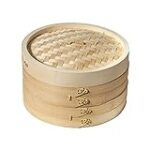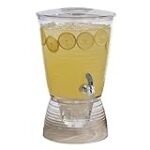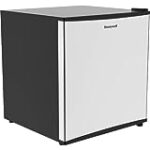🌅 Introduction
Welcome to our comprehensive compost bins buying guide! If you’re looking to reduce waste and create nutrient-rich soil for your garden, compost bins are an essential tool. With so many options available, it can be overwhelming to find the perfect one for your needs. That’s where we come in. In this guide, we’ll walk you through everything you need to know about compost bins, from the different types and sizes to key features and tips for successful composting. So, let’s dive in and find the ideal compost bin that will help you transform your kitchen scraps and yard waste into black gold!
🏆 Our Top 5
- Twin chambers: Two separate chambers allow one side to finish composting while leaving the other side available to add fresh wastes; Constant alternation of the two sides will create an uninterrupted stream of nutritious compost
- 360⁰ Tumbling Design: The rotating design prevents you from digging or mixing the pile by hand; And the deep fins on eight panels make it easier to turn the compost bin
- Excellent Aeration: Air vents can make the air fully circulate and will not cause an explosion due to excessive internal pressure; Deep fins can better break the clumps, which is conducive to the full fermentation of oxygen
- Sturdy & Durable Construction: Constructed of premium metal frame and high-quality pp plastic body, this tumbling composter is corrosion-resistant, weathering-resistant, sturdy, and durable for long-lasting service life
- Garden Gloves Included: The gloves that not only protect your hands from injury, but are also waterproof, making them easy to clean; With 4 durable ABS plastic claws for easy digging, planting and other gardening work
- 【BPA Free Material】 -Made of thick BPA-Free materials, compare with other products, this composter is more environmental-friendly and can withstand the outdoors and the coldest of winters. In addition, the black PP plastic efficiently maintains heat and regulates moisture to obtain shorter composting time
- 【Large Capacity】- This large compost box can hold up a considerable amount of materials, up to 80 gallons (300 L), reducing the procedure frequency and is great for storing transferred compost or yard compost. It is very easy to use. Simply fill it with organice waste (such as old hay, pony poo, and kitchen scraps etc) and wait till it decomposed in 4-6 weeks, you will get vitamin-enriched soil from it to fertilize your veggies and flowers!
- 【Outstanding Aeration Station】-Designed with 4 adjustable air vents on each of the side, together with the deep fins to provide excellent air circulation for composting. With our compost container, you can produce nutrient-rich compost more quickly without digging, sholveling ,or hand mixing
- 【Functional Design】 -This top-loading composter features a handy and secure lid to keep away pesky cirtters from your food scraps and prevent the wind from knocking over the bin. The lid opens and closes with one hand. The lock feature at top and the pull up door at the bottom makes easy also to shovel out compost
- 【Easy to assemble】-Putting it together is a breeze! This composter is easy to assemble and can be completed in 5 minutes! Tips: A rubber mallet will be helpful for driving the snap lock sections together. You will get one-year warranty, so any problem, feel free to contact us!
- Made in Canada from 100% post-consumer recycled plastic - The original 8-sided dual chamber tumbling composter.
- TUMBLING COMPOSTER – Avoid digging and mixing your compost pile by hand. The tumbling design makes mixing easy and efficient. Just close the door and turn it 5-6 times every 2-3 days. In hot sunny conditions and with a proper balance of ingredients the compost can finish in as little as 2 weeks.
- EASY TO USE – Fantastic for beginners! The large openings and removable door make it easy to add scraps/clippings and remove finished compost. Deep fins on the body provide great ergonomic handholds.
- TWO COMPOSTER CHAMBERS ARE BETTER THAN ONE – Two separate sides allow the first side to finish while leaving the second side available to add fresh scraps/clippings. Continuously swapping sides after finishing will create an uninterrupted flow of rich, healthy compost.
- EXCELLENT AERATION – All our composter models feature aeration holes as well as deep fins to break up clumps inside the chamber and mix lots of oxygen into the compost. Tumbling composters allow far greater aeration than standard models.
- Compost bin container properly vents organic materials to allow rapid and proper composting of waste providing a ready supply of nutrient-rich compost to nourish your garden
- Constructed using 80 percent recycled materials and designed to withstand weather and outdoor conditions ensuring durability and long-lasting performance
- Features a lift-off lid and 4-door access providing easy access to fully composted material making your composting process hassle-free and efficient using the composting bin
- Large capacity 65-gallon outdoor compost bin is the ideal solution for creating nutrient-rich compost to enhance the fertility of your garden and backyard soil
- Assembly requires no tools for easy outdoor composter bin set up to quickly get you started with composting in no time; Measures (L x W x H): 26 x 26 x 30.75 inches
- ✅Speed Up Composing Process: More advanced models use rotating to bring oxygen to the center of the bin and paddles inside the chamber to help mix and aerate the composting materials when turned. These improvements or modifications are designed for one reason: to speed the composting process.
- ✅How do Compost Tumblers work? Simple. You load them with green and brown waste from your yard and kitchen. When full, you give them time to work, in other words, heat up. Turning a compost pile mixing the organic materials and the organisms it contains with heat-producing oxygen is the traditional method of keeping the process going full steam. By turning the tumbler, the organic materials are mixed and infused with fresh oxygen.
- ✅Easy to Access Finished Compost: Just Slide the door open and take the organic fertilizer out when the compost is ready. When a check reveals the compost is complete —and this can happen in a matter of weeks —the same access that allowed you to fill the tumbler lets you empty it. Now is the time to spread the results.
- ✅Dual-Bin Design: The dual bin design takes a different approach to the continuous-use composted concept, Two bins are set side-by-side into a single rotating chamber. Thickly insulated compartments conserve the heat generating by the decaying matter, and this greatly speeds the process. This design also allows you to add food waste to one chamber while the other is composting.
- ✅Totally Organic and Money-Saving: If you're looking for a fast, convenient way to compost your kitchen throw-outs, grass clippings, and organic yard waste, our outdoor kitchen compost bin is just right for you! The Compact Compost Tumbler quickly recycles it into nutrient-rich compost.
🤔 How to choose?
1. Size Matters
When it comes to choosing a compost bin, size matters. Consider the amount of organic waste you generate and the available space in your yard or garden. A larger bin may be suitable for households with a large garden or those who generate a significant amount of waste, while a smaller bin may be more appropriate for those with limited space or minimal waste. Remember, a compost bin that is too small may not be able to accommodate all your organic waste, while a bin that is too large may take up unnecessary space.
2. Material Selection
The material of the compost bin is another important factor to consider. Compost bins are commonly made of plastic, wood, or metal. Plastic bins are lightweight, durable, and easy to clean, making them a popular choice for many gardeners. Wood bins, on the other hand, blend seamlessly into the garden and provide a natural aesthetic. Metal bins are sturdy and can withstand harsh weather conditions. Consider the pros and cons of each material and choose the one that best suits your needs and preferences.
3. Ventilation and Aeration
Proper ventilation and aeration are crucial for the success of your composting process. Look for a compost bin that has adequate ventilation holes or slots to allow for proper airflow. This will help prevent the compost from becoming too wet or too dry, ensuring optimal decomposition. Some bins even come with built-in aeration systems, such as tumblers or crank handles, which make turning the compost easier and more efficient.
4. Pest and Odor Control
Nobody wants their compost bin to attract pests or create unpleasant odors. Look for a bin that has a secure lid or cover to keep out unwanted critters. Additionally, consider a bin with a design that promotes proper airflow, as this can help prevent the buildup of odors. Some bins also come with features like charcoal filters or odor-blocking technology to further control any potential smells.
5. Ease of Use and Maintenance
Consider how easy the compost bin is to use and maintain. Look for a bin that is easy to assemble, with clear instructions and minimal parts. Consider whether the bin has a removable bottom or access door, as this can make it easier to remove finished compost. Additionally, think about how easy it will be to turn or mix the compost within the bin. Some bins have features like tumblers or handles that make this process more convenient.
In conclusion, choosing the right compost bin is essential for successful composting. Consider the size, material, ventilation, pest and odor control, and ease of use and maintenance when making your decision. By selecting a bin that meets your specific needs and preferences, you can create nutrient-rich compost to enhance the health and vitality of your garden.
💡 What to Look for in a compost bins?
1. Size and Capacity
When looking for a compost bin, one of the first things to consider is the size and capacity. The size of the bin will depend on the amount of compostable materials you generate and the space available in your garden or backyard.
A small bin with a capacity of 20-30 gallons may be suitable for a small household, while a larger bin with a capacity of 50-100 gallons would be more appropriate for a larger family or avid gardener.
It’s important to choose a bin that can accommodate your composting needs without taking up too much space or overwhelming your garden.
2. Material and Durability
The material of the compost bin is another crucial factor to consider. Compost bins are typically made from plastic, wood, or metal. Each material has its own advantages and disadvantages.
Plastic bins are lightweight, affordable, and easy to clean. However, they may not be as durable as other materials and can degrade over time due to exposure to sunlight and extreme temperatures.
Wooden bins are aesthetically pleasing and blend well with garden surroundings. They are also durable and can last for many years. However, they may require regular maintenance such as sealing or staining to prevent rotting.
Metal bins, such as those made from galvanized steel, are sturdy and long-lasting. They can withstand harsh weather conditions and are resistant to pests. However, they may be more expensive than other options.
Consider the climate in your area, your budget, and your personal preferences when choosing the material for your compost bin.
3. Ventilation and Aeration
Proper ventilation and aeration are essential for successful composting. Without adequate airflow, the composting process can become slow and smelly. Look for a compost bin that has ventilation holes or slots to allow for the circulation of air.
Some bins also come with aeration systems, such as a hand crank or a tumbling mechanism, which helps to mix the compost and introduce oxygen. These features can speed up the decomposition process and produce high-quality compost more quickly.
Additionally, consider the design of the bin. A bin with an open bottom or a perforated base allows for natural aeration and drainage, preventing the compost from becoming waterlogged.
In conclusion, when searching for a compost bin, it’s important to consider the size and capacity, material and durability, as well as ventilation and aeration. By carefully evaluating these factors, you can choose a compost bin that suits your needs and helps you create nutrient-rich compost for your garden. Remember to consider your specific requirements and preferences to find the perfect compost bin for your gardening journey.
🔍 How we picked?
1. Researching the Options
When it comes to choosing the perfect compost bin, it’s important to do your research. With so many options available on the market, it can be overwhelming to know where to start. That’s why we took the time to thoroughly research and compare different compost bins to find the best ones for you.
We scoured online reviews, spoke with gardening experts, and even tested out a few bins ourselves to ensure that we were providing you with the most accurate and reliable information. Our goal was to find compost bins that were not only effective at breaking down organic waste but also durable and easy to use.
2. Evaluating Key Features
After conducting our research, we identified several key features that were important to consider when choosing a compost bin. These features included:
– Size and Capacity: We looked for bins that were large enough to accommodate the amount of organic waste produced by the average household. Additionally, we considered bins that had adjustable capacity options, allowing for expansion as your composting needs grow.
– Material: The material of the compost bin is crucial for its durability and effectiveness. We examined bins made from various materials, such as plastic, metal, and wood. Each material has its own advantages and disadvantages, and we made sure to highlight these in our recommendations.
– Aeration and Moisture Control: Proper aeration and moisture control are essential for the composting process. We sought out bins that had ventilation systems or built-in mechanisms for turning the compost, ensuring that oxygen could reach the organic waste and promoting decomposition.
3. Considering Budget and Value
We understand that budget is an important factor for many consumers. That’s why we made sure to include a range of compost bins at different price points in our buying guide. We wanted to provide options that were not only high-quality but also offered great value for your money.
In addition to considering the upfront cost of the compost bin, we also took into account its long-term value. For example, some bins may require additional accessories or replacement parts, which can add to the overall cost over time. We made sure to highlight any additional expenses associated with each bin to help you make an informed decision.
By thoroughly researching and evaluating the options, considering key features, and taking budget and value into account, we have curated a selection of the best compost bins on the market. Whether you’re a seasoned gardener or just starting out, our buying guide will help you find the perfect compost bin to meet your needs and contribute to a more sustainable lifestyle.
💬 Frequently asked questions about compost bins
1. What is a compost bin and why should I buy one?
A compost bin is a container used to decompose organic waste into nutrient-rich compost. It provides an efficient and eco-friendly way to recycle kitchen scraps, yard waste, and other organic materials. By purchasing a compost bin, you can reduce your carbon footprint, minimize landfill waste, and create a valuable resource for your garden. As the renowned environmentalist, Bill McKibben, once said, “Composting is nature’s way of recycling, and it’s a win-win for both the environment and your garden.”
2. What types of compost bins are available?
There are various types of compost bins available, including tumblers, bins with open bottoms, and worm bins. Tumblers are ideal for those with limited space or who want a faster composting process. Bins with open bottoms allow for direct contact with the soil, promoting better drainage and aeration. Worm bins, also known as vermicomposting bins, use worms to break down organic waste quickly. Each type has its own advantages, so it’s important to consider your specific needs and preferences before making a purchase.
3. How do I choose the right size compost bin?
The size of your compost bin will depend on the amount of organic waste you generate and the available space in your garden. A general rule of thumb is to choose a bin that can accommodate at least one cubic yard of material. However, if you have a small garden or limited waste, a smaller bin may be more suitable. Remember, it’s better to start small and expand later if needed. As the saying goes, “Composting is a journey, not a destination.”
4. Can I compost all types of organic waste?
While most organic waste can be composted, there are some exceptions. Avoid composting meat, dairy products, oily foods, and pet waste, as these can attract pests and create unpleasant odors. Additionally, certain plants, such as invasive weeds or those treated with pesticides, should not be composted. By following these guidelines, you can ensure a healthy and odor-free composting process.
5. How do I maintain and troubleshoot my compost bin?
Maintaining a compost bin is relatively simple. Regularly turn the contents to promote aeration and decomposition. Keep the compost moist, but not overly wet, to facilitate the breakdown of organic matter. If you notice a foul smell, it may indicate an imbalance in the compost, such as too much nitrogen-rich material. In such cases, add carbon-rich materials like dry leaves or shredded paper to restore the balance. Remember, composting is a natural process, and a little trial and error is part of the journey. As the famous gardener, Helen Mirren, once said, “Composting is a bit like cooking – it’s all about finding the right balance of ingredients.”
In conclusion, purchasing a compost bin is a wise investment for both the environment and your garden. By choosing the right type and size, composting a variety of organic waste, and maintaining your bin properly, you can create nutrient-rich compost to nourish your plants and contribute to a more sustainable future. So, why wait? Start composting today and reap the benefits of this natural recycling process.
Last update on 2024-07-25 / Affiliate links / Images from Amazon Product Advertising API
